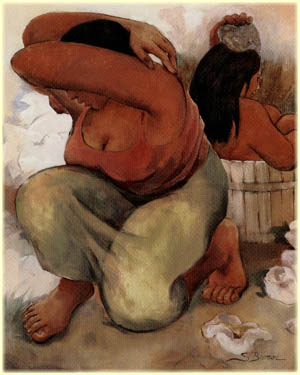 Sandra Bierman
Sandra Bierman
By Judy Hughes Archibald
Sandra Bierman's larger-than-life paintings are powerful because she is unafraid of sharing her feelings. It is Bierman's own joy over the birth of a grandchild we experience in CIRCLE OF LIGHT. Likewise, we sense her sadness in the haunting blue tones of MOTHER EARTH, which was painted as an outpouring of grief after her 23-year-old son was diagnosed with schizophrenia. "I didn't know I was recording my feelings," she says. "But once I finished the painting I realized the woman carrying the weight of the world on her shoulders was me."
Bierman has chosen to make relationships the focus of her art because she lacked a secure, stable family life while growing up. "I guess I try to create my own little House on the Prairie," she says. Sad memories are turned into paintings with happier overtones. Though THE BATH may be a reminder of living in a cabin without water or electricity, its colors and bold shapes translate into a beautiful wish for what might have been.
The one positive influence in Bierman's life was her maternal grandmother, a large, nurturing woman of part Cherokee heritage who lived a difficult life. "She taught me how to sew and make things out of wood," says Bier-man. "She was a Mother Nature type. I don't know if I would have survived without her."
"Granny" is the inspiration for many of Bierman's earthy figures, while the babies represent her own children and grandchildren. And every red, blue and green cat is really a white one that she loved and whose memory she now keeps alive on her canvases
Though Bierman is small-boned and trim, she also sees herself as the large, round women in many of the paintings. "Still, the size of the figure is influenced by my big, nurturing granny," she laughs. Portions of Bierman's Earth Mother figures are purposely enlarged to allow parts of the body to speak to the viewer. If the arms of a woman are encircling a child, they are frequently exaggerated so that the viewer not only sees a hug but feels it.
During a recent trip to Sweden, where Bierman met her father's family for the first time, she was impressed with the work of sculptor Gustav Vigeland [1869-1943]. In his figurative sculpture, Vigeland exaggerates hands and feet, capturing the viewer's eye with solid forms, circles and lines. "He creates in stone what I create in my paintings," she says. "Seeing his work somehow affirmed my own impressions."
Because she paints intuitively, Bierman does not refer to models or photographs when working. "I don't want to be even subconsciously influenced to paint what I see rather than what I feel," she says. . Excited by the art-making process, she refers to painting with oils as "a dance, a celebration of life" and gracefully moves between several canvases in various stages of development. She works spontaneously, without preliminary sketches or drawings, often beginning with circular compositions that allude to volume and capture attention through symmetry, rhythm and shape. Negative space is as important as the main image. "I want a painting to be as balanced upside down as it is right-side up," she says.
Style, subject matter and corn-position are consistent and easily recognizable as the "Bierman signature," but her technique and process constantly change. Sometimes she begins by wiping color onto a canvas with a rag, allowing light to show through until a cat, baby or face demands to be brought out-"as if the canvas is telling me what to do rather than me taking charge," she says. At other times she uses white and umber underpainting to lay in basic areas of tone before glazing on color, or she may begin by drawing the entire composition on canvas with charcoal and then painting over it with a brush, palette knife or even a pot scrubber. Unlike many artists who are content to stay with a technique that feels comfortable, Bierman says, "There is a banquet of methods out there, and I want to taste them all." She prefers oil-based pigments because of their versatility, softness and slow drying time. Her palette moves from subtle earth tones to vibrant impastos. Rather than using color to draw the viewer's attention, however, Bierman creates eye movement with unusual perspectives, undulating lines and juxtapositions of dark and light, The latter is especially compelling when seen in a dramatic light source such as a candle or an imagined one such as the glowing arms of a maternal figure. The joy of painting to Bierman, "is the never-ending journey of exploration It is elusive like chasing a rainbow," she says.
The rare male figures that appear in Bierman's work are usually part of a contented family unit, as in FAMILY. "My work is about women," she says. "I think of earth, life, trees and nature as being feminine, and that is what I paint." Even when a painting has an undercurrent of sadness, the women remain nurturing, strong, and healing-a lot like Bierman, who has made a conscious decision to survive. At the moment, her life is blissful, and she has let the weight of the world fly away, much as it does on the wings of an owl depicted in one of her paintings. Sandra Bierman has come full circle.
 INTO THE LIGHT
INTO THE LIGHT
Though it may appear that success has come quickly for Bierman, it is based on an introspective journey over a lifetime that has included pain and ugliness as well as joy and beauty.
Born in Brooklyn, NY, Bierman's first art award came at age 12 while she was living in a public housing project. Bierman created a small clay sculpture of a flying horse that won her a scholarship to a watercolor class. When she graduated from high school, she received a four-year scholarship to the Maryland Institute of Art, but dropped out to marry a Naval Academy midshipman.
While her husband attended law school, Bierman supported them both by working as a fashion model in New York, NY, while studying at night with well-known figurative painters such as John Grabach, Daniel Greene and Frank Mason at the Art Students League in Manhattan. Her art began to receive recognition, but a divorce and raising three children alone forced her to forsake art and pursue a more practical career in telecommunications. Though she achieved an upper-management position at Chase Manhattan Bank, Bierman says, "I always felt like a fish out of water."
When she fled the corporate world for the Catskill Mountains, Bierman hadn't painted seriously in a long while. She immediately signed up for classes at the Woodstock School of Art and was relieved to find her talent still there, waiting to be tapped.
A move to Colorado in 1988 sparked an introspective journey that proved to be a turning point in her art career. Getting in touch with her inner self, Bierman began to see sensuous metaphors in the physical shapes of the foothills near her Boulder home and in the pure light, expansiveness and freedom of the West. Now happily married to a physics professor, she says, "Finally, I feel that I really belong."
from Southwest Art, April 1997
Return to Reviews